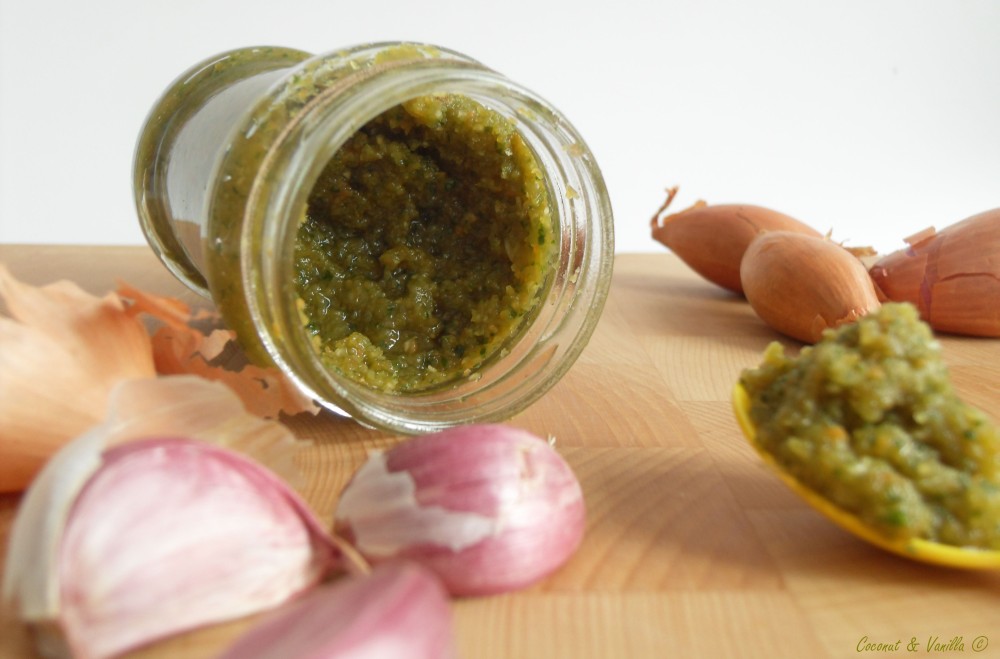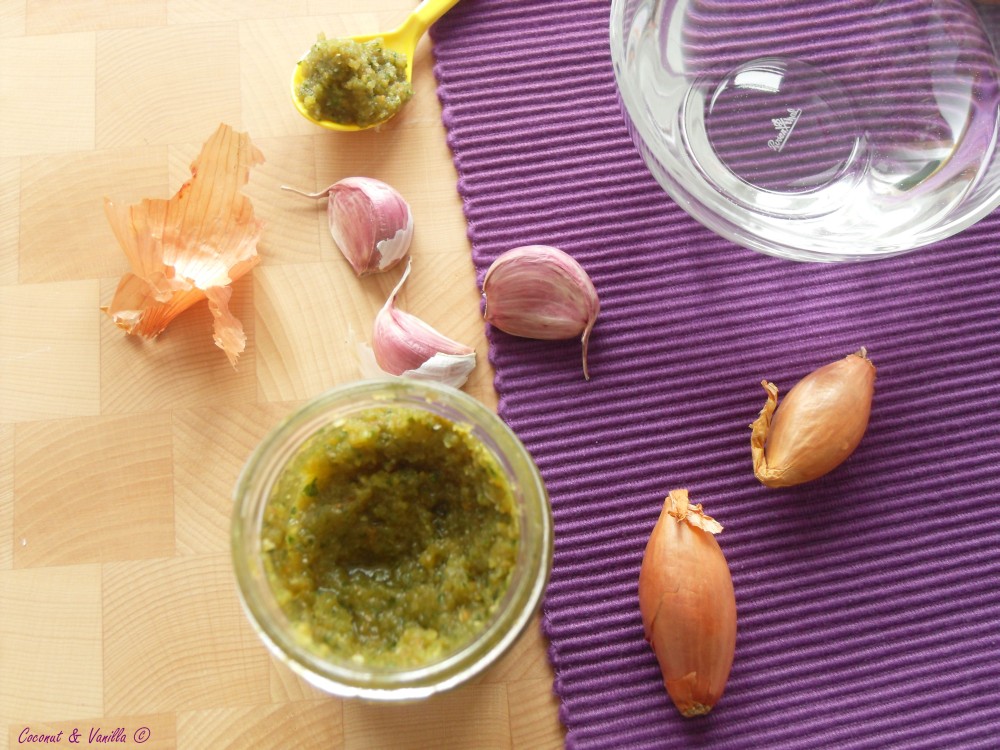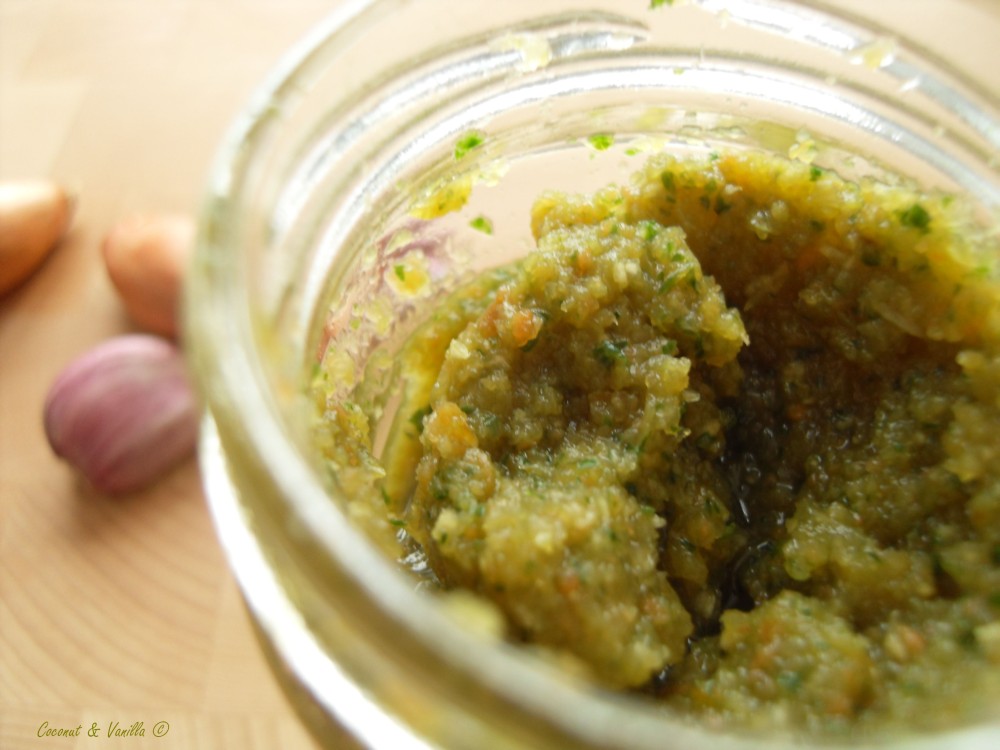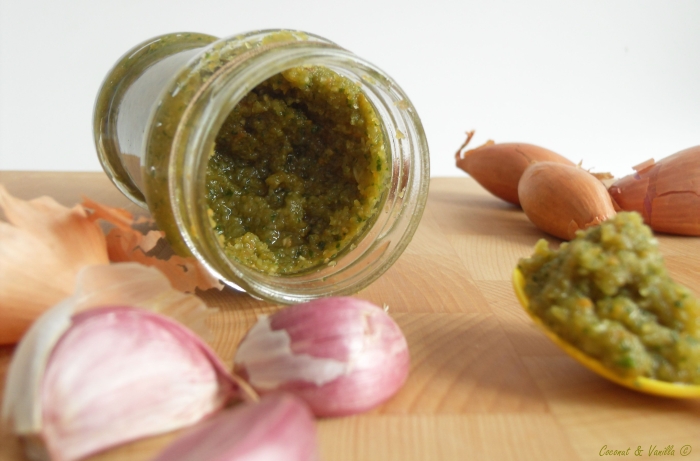Upate: Für das deutsche Rezept nach unten scrollen!

As I was ill the last two weeks, I wanted to do more for my blog. I made some things – I swear! But it happened, that those things were not good enough for my blog. Unfortunately.
Now that I’m back to work, I’ve done some great things and even more great photos of it! But just no time to write. So this evening I just take the time.
In my ill-time I had a lot of time to read lots of blogs, recipes and other interesting things. I got hold on a simple recipe making your own bouillon paste of vegetables. Since I’m very into making everything on my own, I was thrilled.

Since I’m not a fan of glutamate in food, I’m using only organic granulated bouillon, because it never contains glutamate. But it can contain other things that you don’t want in there, for example gluten or allergens. So making your own paste, disposes this problem. And of course it’s just great to make your own bouillon, without making a real stock!

I adapted the recipe from 101 Cookbooks. You can vary, which vegetables you use and also the ratio. I do not like celery stalks. But I like the root. So I just used that. Equally I do not like cilantro, thus I used just parsley. However It would be interesting to add some basil the next time or parsnips.

It’s recommended to use a food processor. As I do not have one, I thought optimistic and use my blender. Hmmm… wasn’t that good idea. It didn’t get the leek and the carrots alright. Celery was good with it. In the end I used my immersion blender. It took some time longer I think (since I can’t compare), but it worked very well and I got a moist paste. I didn’t used as much salt, as stated in the „original“ recipe. Maybe that leads rather to a „creamy“ paste, than a loose paste. For me it’s salty enough and if not, adding salt is less a problem, than to withdraw some.
My recommendation is to dissolve 2,5 tsp. per 250 ml (1 cup). It dissolves very good, if you wonder ;-).
I put one jar of the bouillon in the fridge and froze the rest in portions. If you are not using that much bouillon, you can freeze it in ice cube trays, so your portions to thaw are very small. I froze the rest in three portions, every equal to the amount in my fridge. It yields about four 200ml jars.

Selbstgemachte Gemüsebouillonpaste
nach einem Rezept von 101 Cookbooks
Zutaten:
- 150 g Lauch
- 200 g Fenchel
- 200 g Möhren
- 200 g Sellerie (ich nehme Knollensellerie)
- 30 g getrocknete Tomaten
- 100 g Schalotten, geschält
- 3 Knoblauchzehen, geschält
- 150 g feines Meersalz
- 80 g glatte Petersilie
Das Gemüse waschen.
Den Lauch halbieren und in Scheiben schneiden. Den Sellerie schälen und in Stücke schneiden. Ebenso Möhren, Knoblauch und die Schalotten. Die Petersilie grob hacken.
Wenn ihr einen Pürierstab verwendet, ist es leichter, wenn man das Gemüse in kleine Stücke schneidet.
Die ersten 4 Zutaten in die Küchenmaschine geben und etwa 20 Mal pulsen. Alternativ mit dem Pürierstab pürieren. Die anderen Zutaten dazugeben und pürieren bis man eine feuchte Paste bekommt. Mit dem Pürierstab kann das länger als 5 Minuten dauern.
Die Paste in ein kleines Glas füllen und den Rest portionsweise einfrieren.
2,5 TL auf 250 ml kochendes Wasser verwenden.
Die Paste hält sich sehr lange im Kühlschrank.

As I was ill the last two weeks, I wanted to do more for my blog. I made some things – I swear! But it happened, that those things were not good enough for my blog. Unfortunately.
Now that I’m back to work, I’ve done some great things and even more great photos of it! But just no time to write. So this evening I just take the time.
In my ill-time I had a lot of time to read lots of blogs, recipes and other interesting things. I got hold on a simple recipe making your own bouillon paste of vegetables. Since I’m very into making everything on my own, I was thrilled.

Since I’m not a fan of glutamate in food, I’m using only organic granulated bouillon, because it never contains glutamate. But it can contain other things that you don’t want in there, for example gluten or allergens. So making your own paste, disposes this problem. And of course it’s just great to make your own bouillon, without making a real stock!

I adapted the recipe from 101 Cookbooks. You can vary, which vegetables you use and also the ratio. I do not like celery stalks. But I like the root. So I just used that. Equally I do not like cilantro, thus I used just parsley. However It would be interesting to add some basil the next time or parsnips.

It’s recommended to use a food processor. As I do not have one, I thought optimistic and use my blender. Hmmm… wasn’t that good idea. It didn’t get the leek and the carrots alright. Celery was good with it. In the end I used my immersion blender. It took some time longer I think (since I can’t compare), but it worked very well and I got a moist paste. I didn’t used as much salt, as stated in the „original“ recipe. Maybe that leads rather to a „creamy“ paste, than a loose paste. For me it’s salty enough and if not, adding salt is less a problem, than to withdraw some.
My recommendation is to dissolve 2,5 tsp. per 250 ml (1 cup). It dissolves very good, if you wonder ;-).
I put one jar of the bouillon in the fridge and froze the rest in portions. If you are not using that much bouillon, you can freeze it in ice cube trays, so your portions to thaw are very small. I froze the rest in three portions, every equal to the amount in my fridge. It yields about four 200ml jars.

Homemade Bouillon Paste
adapted from 101 Cookbooks
Ingredients:
- 150 g leeks
- 200 g fennel
- 200 g carrots
- 200 g celery (I prefer roots)
- 30 g sun-dried tomatoes
- 100 g shallots, peeled
- 3 cloves garlic, peeled
- 150 g fine grain sea salt
- 80 g flat-leaf parsley
Wash the vegetables.
Slice the leeks. Peel the celery. Chop the fennel, carrots, celery, shallots and garlic. Chop the parsley loosely.
If you are using an immersion blender, it’s easier for you to cut the vegetables into smaller pieces. Place the first four ingredients in your food processor and pulse about 20 times. Or puree with your immersions blender. Add the other ingredients and puree as long as you get a moist paste. If you use an immersion blender it can take over 5 minutes.
Fill in a jar and keep it in the fridge. Freeze the rest in portions.
Use 2,5 tsp. of bouillon per 250ml (1 cup) boiling water.

